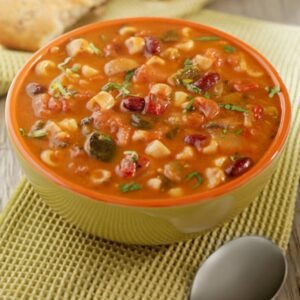Minestrone recipe

Minestrone: The Original “Kitchen Sink” Soup
(But Way Tastier)
Minestrone, a hearty Italian soup with a history as colorful as its vegetable medley, is basically the culinary equivalent of cleaning out your fridge. Except, unlike the questionable concoctions that emerge from such endeavors, minestrone is a symphony of flavors, a celebration of leftovers, and a champion of improvisation.
The origin story of minestrone is as jumbled as the ingredients themselves. Some say it originated in ancient Rome, where frugal cooks tossed leftover vegetables into a pot with some barley and called it a day. Others claim it hails from medieval Italy, where peasants used whatever was in season to create a nourishing meal.
One thing’s for sure: minestrone is a testament to human ingenuity. It’s the ultimate “waste not, want not” dish, a delicious reminder that sometimes, the best meals come from using what you have on hand. Just don’t throw in that week-old container of yogurt lurking in the back of the fridge. Trust us.
Recipe: Minestrone – A Symphony of Leftovers
(in a Good Way)
The beauty of minestrone lies in its adaptability. This recipe is just a suggestion, a springboard for your own culinary creativity. Feel free to throw in whatever vegetables your heart (and fridge) desires!
Ingredients:
- The Base:
- Olive oil – 2 tablespoons (because everything’s better with olive oil)
- Onion – 1, chopped (not enough to make you cry, but enough to add some depth)
- Garlic – 2 cloves, minced (keep the vampires at bay)
- Carrots – 2, diced (because everyone needs a little orange in their life)
- Celery – 2 stalks, diced (add some crunch!)
- The Vegetable Medley: (Pick your favorites, or get wild!)
- Diced zucchini – 1
- Chopped green beans – 1 cup
- Canned diced tomatoes – 1 (14.5 oz) can (fire-roasted if you’re feeling fancy)
- Frozen peas – 1 cup (because peas are fun and tiny and green)
- Cannellini beans (rinsed and drained) – 1 cup (for a protein punch)
- The Broth Brigade:
- Vegetable broth – 4 cups (low-sodium if you’re watching your salt intake)
- Dried oregano – 1 teaspoon
- Bay leaf – 1 (for a touch of bay-ness, obviously)
- Salt and freshly ground black pepper – to taste (because bland minestrone is a crime)
- The Grand Finale:
- Pasta (small shapes like ditalini or orzo work best) – 1/2 cup (uncooked)
- Freshly grated Parmesan cheese – for serving (because cheese makes everything better)
Instructions:
- The Sauté Symphony: Heat the olive oil in a large pot over medium heat. Sauté the onion, garlic, carrots, and celery until softened and fragrant. Basically, you’re creating the base flavor orchestra.
- The Vegetable Chorus: Add your chosen vegetables (except the peas and pasta) to the pot. Let them simmer for a few minutes, getting to know each other and mingling their flavors.
- The Brothy Crescendo: Pour in the vegetable broth, oregano, and bay leaf. Bring to a boil, then reduce heat and simmer for 15-20 minutes, or until the vegetables are tender. This is where the magic happens, the flavors melding into a harmonious whole.
- The Pasta Pirouette: Add the peas and pasta to the pot. Simmer for another 5-7 minutes, or until the pasta is cooked through. The pasta is the graceful dancer twirling in the flavorful broth.
- The Grand Finale: Season with salt and pepper to taste. Remove the bay leaf (it’s done its job conducting the flavor symphony).
- Serve Up the Smiles: Ladle the minestrone into bowls and top with a generous sprinkle of Parmesan cheese. Get ready for a round of applause (or at least happy slurping noises).
There you have it! Minestrone, a delicious example of how sometimes, the best meals come from using what you have on hand. So, unleash your inner culinary maestro, raid your fridge, and create your own minestrone masterpiece! Just remember, the only wrong ingredient is a bad attitude. Because minestrone is all about celebrating the joy of leftovers, and the delicious possibilities they hold.
